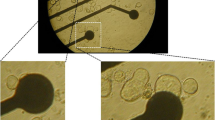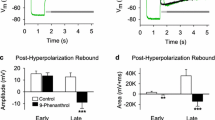Summary
-
1.
The effect of polarizing currents, ions and drugs on the action potentials of individual neurones in the sub-oesophageal ganglion of the snail Helix pomatia has been examined.
-
2.
The current-voltage relation showed a marked decrease of resistance for the outward current (delayed rectification). AtI=0, the average membrane resistance was 8.3 kΩ×cm2.
-
3.
Tetrodotoxin in a concentration of 4.6×10−6 g/ml did not affect the overshoot or the maximum rate of rise. 0.4% cocaine inhibited delayed rectification, but did not abolish the action potential.
-
4.
Ringer solution with twice the normal Na concentration augmented the overshoot by 5–6 mV and increased the maximum rate of rise to 130% of its normal value. Na-free Ringer decreased the overshoot by only 5–8 mV and reduced the maximum rate of rise to about half its normal value.
-
5.
Even after prolonged perfusion with Na-free solution action potentials were still obtained. The overshoot stayed constant during a 2 hours perfusion period whereas the maximum rate of rise declined slowly. Na-free Ringer with Mn depressed the spike.
-
6.
Raising the Ca concentration of the Na-free Ringer increased the overshoot (average 15.9 mV for a 10-fold increase of [Ca]0), shifted the threshold potential towards zero and slightly augmented the maximum rate of rise.
-
7.
Nominally Ca-free solution markedly reduced the action potential. Excitability was maintained in Na- and Ca-free Ringer with 10 mM Sr or Ba.
-
8.
Part of the results could be explained by assuming a reservoir of Na+ ions in or close to the cell membrane. An alternative explanation is that Ca++ ions participate in carrying charge across the membrane during the rising phase of the action potential. The second hypothesis appears more likely although a definite decision could not be reached.
Similar content being viewed by others
References
Abbot, B. C., andI. Parnas: Electrical and mechanical responses in deep abdominal extensor muscles of crayfish and lobster. J. gen. Physiol.48, 919–931 (1965).
Araki, T., andT. Otani: Response of single motoneurons to direct stimulation in toad's spinal cord. J. Neurophysiol.18, 472–485 (1955).
Arvanitaki, A., G. Romey etH. Takeuchi: Variations de la relation caractéristique V(i) de la neuromembrane en fonction de lapO2. Implications fonctionelles. C. R. Soc. Biol. (Paris)161, 1629–1633 (1967).
Bullock, T. H., andG. A. Horridge: Structure and function in the nervous systems of invertebrates, Vol. I and II. San Francisco-London: W. H. Freeman & Co. 1965.
Chamberlain, S. G., andG. A. Kerkut: Voltage clamp studies on snail (Helix aspersa) neurones. Nature (Lond.)216, 89 (1967).
Chandler, W. K., A. L. Hodgkin, andH. Meves: The effect of changing the internal solution on sodium inactivation and related phenomena in giant axons. J. Physiol. (Lond.)180, 821–836 (1965).
David, G. B.: Cytoplasmic networks in neurons. In: Comparative Neurochemistry, ed. byD. Richter. London: Pergamon Press 1964.
Fatt, P., andB. L. Ginsborg: The ionic requirements for the production of action potentials in crustacean muscle fibres. J. Physiol. (Lond.)142, 516–543 (1958).
—, andB. Katz: The electrical properties of crustacean muscle fibres. J. Physiol. (Lond.)120, 171–204 (1953).
Frankenhaeuser, B., andA. L. Hodgkin: The action of calcium on the electrical properties of squid axons. J. Physiol. (Lond.)137, 217–244 (1957).
Gerasimov, V. D.: Effect of ion composition of medium on excitation process in giant neurons of snail. Fiziol. Sh. SSSR50, 457–463 (1964).—Fed. Proc.24, T 371–374 (1965).
—,L. Janiszewski, andE. Skubaljanka: Rectifier properties of the membrane of giant neurones in solutions of varying ion composition. Biofizika12, 97–103 (1967) (in Russian).
—,P. G. Kostyuk, andV. A. Maiskii: Excitability of giant nerve cells of various pulmonate mollusks in sodium-free solutions. Byull. éksp. Biol. Med.58, 3–6 (1964).—Fed. Proc.24, T 676–678 (1965).
———: Influence of divalent cations on electrical characteristics of giant neurone membrane. Biofizika10, 447–453 (1965) (in Russian).
Gerschenfeld, H. M., andA. Lasansky: Action of glutamic acid and other naturally occurring amino-acids on snail central neurons. Int. J. Neuropharmacol.3, 301–314 (1964).
Gola, M.: Effets de lapO2 sur la résistance électrique de la neuromembrane d'Helix pomatia. C. R. Soc. Biol. (Paris)161, 1634–1638 (1967).
Goldman, D. E.: Potential, impedance, and rectification in membranes. J. gen. Physiol.27, 37–60 (1943).
Hagiwara, S., andK.-I. Naka: The initiation of spike potential in barnacle muscle fibers under low intracellular Ca++. J. gen. Physiol.48, 141–162 (1964).
—, andS. Nakajima: Differences in Na and Ca spikes as examined by application of tetrodotoxin, procaine, and manganese ions. J. gen. Physiol.49, 793–806 (1966).
—, andK. Takahashi: Surface density of calcium ions and calcium spikes in the barnacle muscle fiber membrane. J. gen. Physiol.50, 583–601 (1967).
Hille, B.: Charges and potentials at the nerve surface. Divalent ions and pH. J. gen. Physiol.51, 221–236 (1968).
Hodgkin, A. L., andB. Katz: The effect of sodium ions on the electrical activity of the giant axon of the squid. J. Physiol. (Lond.)108, 37–77 (1949).
Junge, D.: Multi-ionic action potentials in molluscan giant neurones. Nature (Lond.)215, 546–548 (1967).
Kandel, E. R., andL. Tauc: Anomalous rectification in the metacerebral giant cells and its consequences for synaptic transmission. J. Physiol. (Lond.)183, 287–304 (1966).
Kao, C. Y.: Tetrodotoxin, saxitoxin and their significance in the study of excitation phenomena. Pharmacol. Rev.18, 997–1049 (1966).
Kerkut, G. A., andD. R. Gardner: The role of calcium ions in the action potentials of Helix aspersa neurones. Comp. Biochem. Physiol.20, 147–162 (1967).
—, andR. W., Meech: The effect of ions on the membrane potential of snail neurones. Comp. Biochem. Physiol.20, 411–429 (1967).
—, andR. C. Thomas: The effect of anion injection and changes in the external potassium and chloride concentration on the reversal potentials of the IPSP and acetylcholine. Comp. Biochem. Physiol.11, 199–213 (1964).
——: An electrogenic sodium pump in snail nerve cells. Comp. Biochem. Physiol.14, 167–183 (1965).
—, andR. J. Walker: The specific chemical sensitivity of Helix nerve cells. Comp. Biochem. Physiol.7, 277–288 (1962).
Koketsu, K., andS. Nishi: Calcium spikes of nerve cell membrane: Role of calcium in the production of action potentials. Nature (Lond.)217, 468–469 (1968).
Maiskii, V. A.: Electrical characteristics of surface membrane of the giant nerve cells of Helix pomatia. Fiziol. Sh. SSSR49, 1468 (1963).—Fed. Proc.23, T 1173–1176 (1964).
Meves, H.: Das Aktionspotential der Riesennervenzellen der Weinbergschnecke Helix pomatia. Pflügers Arch. ges. Physiol.289, R 10 (1966).
—: Calciumströme durch erregbare membranen. Elektrophysiologische Untersuchungen an den Riesennervenzellen der Weinbergschnecke Helix pomatia. Ber. Bunsenges. physik. Chem.71, 831–834 (1967).
Moreton, R. B.: An application of the constant-field theory to the behaviour of giant neurones of the snail, Helix aspersa. J. exp. Biol.48, 611–623 (1968a).
— Ionic mechanism of the action potentials of giant neurones of Helix aspersa. Nature (Lond.)219, 70–71 (1968b).
Nakamura, Y., S. Nakajima, andH. Grundfest: The action of tetrodotoxin on electrogenic components of squid giant axons. J. gen. Physiol.48, 985–996 (1965).
Niedergerke, R., andR. K. Orkand: The dual effect of calcium on the action potential of the frog's heart. J. Physiol. (Lond.)184, 291–311 (1966).
Oomura, Y., S. Ozaki, andT. Maéno: Electrical activity of a giant nerve cell under abnormal conditions. Nature (Lond.)191, 1265–1267 (1961).
Ozeki, M., A. R. Freeman, andH. Grundfest: The membrane components of crustacean neuromuscular systems. I. Immunity of different electrogenic components to tetrodotoxin and saxitoxin. J. gen. Physiol.49, 1319–1334 (1966).
Rall, W.: Branching dendritic trees and motoneuron membrane resistivity. Exp. Neurol.1, 491–527 (1959).
—: Membrane potential transients and membrane time constant of motoneurons. Exp. Neurol.2, 503–532 (1960).
Reuter, H.: The dependence of slow inward current in Purkinje fibres on the extracellular calcium-concentration. J. Physiol. (Lond.)192, 479–492 (1967).
Takeda, K.: Permeability changes associated with the action potential in procainetreated crayfish abdominal muscle fibers. J. gen. Physiol.50, 1049–1074 (1967).
Tauc, L.: Les divers modes d'activité du soma neuronique ganglionnaire de l'aplysie et de l'escargot. In: Microphysiologie comparée des éléments excitables. Centre National de la Recherche Scientifique. Paris 1957.
—, andH. M. Gerschenfeld: Effet inhibiteur ou excitateur du chlorure d'acétylcholine sur le neurone d'Escargot. J. Physiol. (Paris).52, 236 (1960).
—, andG. M. Hughes: Modes of initiation and propagation of spikes in the branching axons of molluscan central neurons. J. gen. Physiol.46, 533–549 (1962).
Thomas, R. C.: Measurement of current produced by the sodium pump in a snail neurone. J. Physiol. (Lond.)195, 23–24 P (1968).
Walker, R. J., andA. Hedges: The effect of cholinergic agonists on the spontaneous activity of neurones of Helix aspersa. Comp. Biochem. Physiol.24, 355 to 376 (1968).
Weed, R. I., andA. Rothstein: The uptake of divalent manganese ion by mature normal human red blood cells. J. gen. Physiol.44, 301–314 (1960).
Werman, R., andH. Grundfest: Graded and all-or-none electrogenesis in arthropod muscle. II. The effects of alkali-earth and onium ions on lobster muscle fibers. J. gen. Physiol.44, 997–1027 (1961).
Author information
Authors and Affiliations
Rights and permissions
About this article
Cite this article
Meves, H. The ionic requirements for the production of action potentials in helix pomatia neurones. Pflugers Arch. 304, 215–241 (1968). https://doi.org/10.1007/BF00592126
Received:
Issue Date:
DOI: https://doi.org/10.1007/BF00592126




